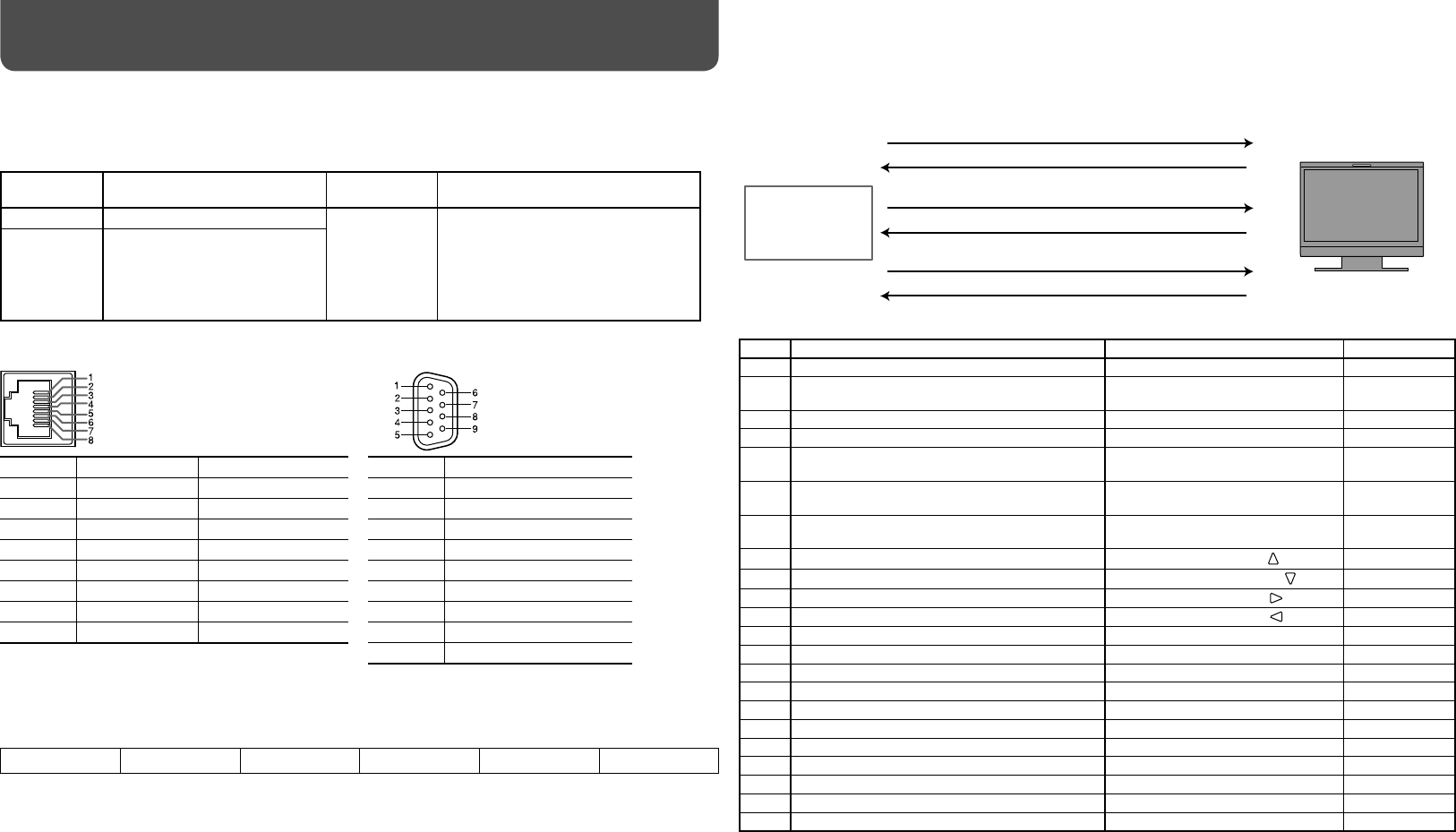
18
1 Starting the communication:
connection command (!00BCN1Cr)
3 Selecting “SDI 1” input (!00BINACr)
5 Terminating the communication: termination command
(!00BCN0Cr)
6 Monitor’s status (@00BOKCr)
4 Monitor’s status (@00BOKCr)
2 Monitor’s status (@00BOKCr)
PC, etc.
7 Using the serial communication
You can control the monitor from a personal computer etc. via the RS-485 or RS-232C terminal.
• Consult your dealer for the details of the external control specification.
<Communication specifications>
Input terminal Cable
Terminal
specification
Communication specifications
RS-485 A straight LAN cable
☞ See below
Baud Rate: 4800 bps
Data Bits: 8 bits
Parity: No parity
Stop Bits: 1 bit
Flow Control: No control
Communication Code: ASCII Code
RS-232C A straight cable with a D-sub 9-pin
connector (male for the monitor,
female for the personal computer
etc.)
<Specifications of the RS-485 terminal> <Specifications of the RS-232C terminal>
Pin No. IN terminal signal OUT terminal signal Pin No. Signal
1
TXD + TXD +
1
NC
2
TXD – TXD –
2
RXD
3
RXD + RXD +
3
TXD
4
NC NC
4
NC
5
NC NC
5
GND
6
RXD – RXD –
6
NC
7
NC NC
7
RTS
8
GND GND
8
CTS
9
NC
• The 7th terminal and the 8th terminal are connected.
<Command outline>
All commands consist of the following segments.
Header Monitor ID Command ID Function Data Cr (0DH)
On Header
“!”: Operation commands from the personal computer, etc. For details, see <Basic command list> on the right.
“?”: Reference commands from the personal computer, etc.
“@”: Status returns from the monitor
• To start communication, send the connection command from the personal computer etc.
• To terminate the communication, send the termination command from the personal computer etc.
This is a female terminal. This is a female terminal.
Example of communication procedures
<Basic command list>
No. Commands Functions Data
1!
*
**
1
B C N 1 Cr Starts communication (connection) No data
2!
*
**
1
BCN0Cr
Terminates communication
(termination)
No data
3!
*
**
1
BIDSETxx*
2
Cr Assigns the control ID 01 – 99
4!
*
**
1
B I D R E T Cr Initializes the control ID No data
5!
*
**
1
BIDDSPxx*
2
Cr Displays/hides the ID
00: Hide
01: Display
6!
*
**
1
BIDCHKxx*
2
Cr
Flashes/hides the selected ID No. of
the monitor
00: Hide
01: Display
7!
*
**
1
BMENUCr
Displays the MAIN MENU/Quits the
menu operation
No data
8!
*
**
1
BUPCr
Moves the cursor upward ( )
No data
9!
*
**
1
BDOWNCr
Moves the cursor downward ( )
No data
10 !
*
**
1
B A D J R Cr Makes setting/adjustment ( ) No data
11 !
*
**
1
B A D J L Cr Makes setting/adjustment ( ) No data
12 !
*
**
1
B S E T U P Cr Displays the SET-UP MENU No data
13 !
*
**
1
B P W 1 Cr Turns on the monitor No data
14 !
*
**
1
B P W 0 Cr Turns off the monitor (on standby) No data
15 !
*
**
1
B I N A Cr Selects “SDI 1” input No data
16 !
*
**
1
B I N B Cr Selects “SDI 2” input No data
17 !
*
**
1
B I N C Cr Selects “DVI” input No data
18 !
*
**
1
B I N D Cr Selects “COMPO.” input No data
19 !
*
**
1
B I N E Cr Selects “VIDEO” input No data
20 !
*
**
1
B D I S P Cr Displays the status*
3
No data
21 !
*
**
1
BAMUTExx*
2
Cr Turns muting on/off 00: Off, 01: On
22 !
*
**
1
BASPxx*
2
Cr Changes the aspect ratio 00: 4:3, 01: 16:9
• “Cr” is 0Dh.
• The commands for starting communication (connection) (No. 1), terminating communication (termination)
(No. 2), and turning on the monitor (No. 13) can be used while the monitor is off (on standby).
*
1
Enter the monitor’s ID for “ **.” The initial setting of the monitor’s ID is “00.” When connecting several monitors, “00” is a
command for controlling all monitors at once.
*
2
Enter the appropriate data to “xx.”
*
3
Displays the information shown when the INPUT SELECT button currently lit is pressed (☞ “On the Status Display” on
page 7).
Monitor
External Control (cont.)


















